
Полная версия
Street Knowledge
‘I’ve always been attracted to graffiti and to people who do things that they’re not supposed to.’
Having spent years knee-deep in the Melbourne stencil scene, Jim knows better than most what he likes and, more importantly, what he doesn’t:
‘I’ve decided that most New York/train-oriented graf is very derivative. As a culture, it often doesn’t support innovation and experimentation. But these are the primary things that I find exciting in all creative endeavours. That’s why I find outsider graffiti so exciting, because it doesn’t adhere to a set of rules and is often unpredictable.’
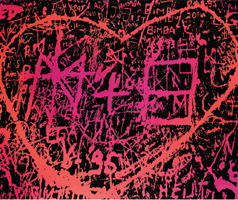
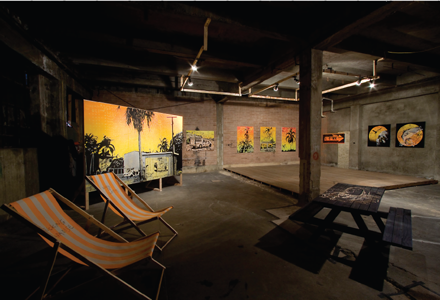
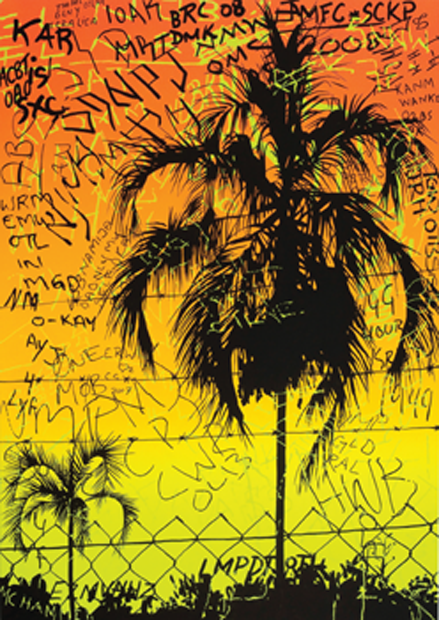
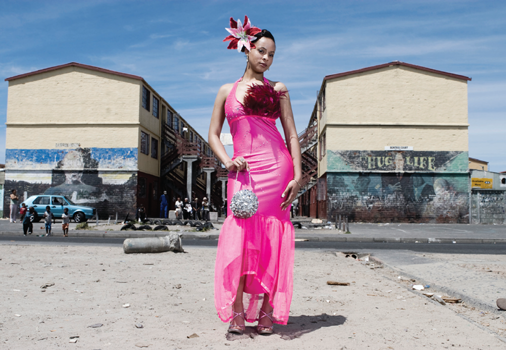
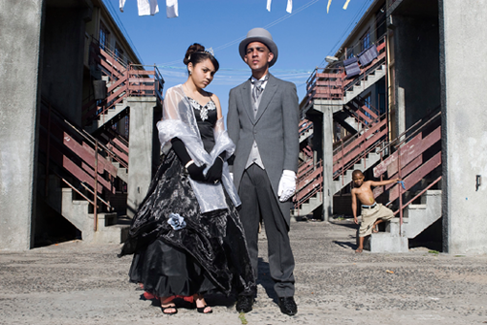
ARAMiNTA DE CLERMONT
Araminta has a great story about how she got into photography and subsequently how she shot two different sides to South African — more specifically, Cape Town — life. ‘Prison gang tattoos and matric’ dresses’ for her first exhibition. (Matric’ is short for Matriculation and is when you spend your last year at high school and graduate, like the US high school prom. Then you have a graduation party and this is when the dress comes in!) The moment I spotted her work I knew that she had something special and I had to get her in here. I’ll let her tell you her story in her own words…
‘I did an architecture course in England but what I really liked was shuffling around London looking at sites I was given. I really enjoyed that bit. And then I studied it at St Martins, which was quite an odd course as it hadn’t really started as a course properly, it was just me and another girl. I had walked in off the street and said “Do you do a photography post-graduate?” and so they said, “No, but talk to the tutor who basically had to shoot all the fashion,” and he was rather bored. So he made us a course, which was lovely. And what happened was by then I had a terrible drug habit and everything went a bit pear-shaped for years and then I came out to Cape Town for treatment and rehab. I just locked myself in the darkroom in London and used it as an excuse to do what I wanted and when I came out to South Africa I started shooting properly and also I found that I had all these ideas.
‘It was because of the drug stuff that enabled me to meet the 28s and the 26s [prison gangs], really. When I came out here I had the most horrendous scars, almost disfiguring, on my face, but when I met the prison gangs, the first thing I thought was that the tattoos were such a rich art form in their own right, and I found it so fascinating, and also interesting because of my own scars. Which were nothing compared to the branding that the gangsters get from their face tattoos. It was very healing for me to see this. I had empathy for them as I had made my face peculiar as well. But I had the best year and a half with them because they are like the most amazing men and their stories are incredible. The tattoo is a kind of way for a human being to express themself when they have had everything else taken away.
‘I actually was going to do the matric’ photos across the board, all the people, but I became really interested in the Cape Flats (a notorious area of Cape Town, (>p270)) where the kids there have the best dresses, the most imagination for the one night they can style on. It was quite grinding to shoot the gangsters and I was quite happy to shoot something fun. The girls were full of self-expression and really into making a statement. They all think about the dress they are gonna wear for about five years and the parents spend every penny on it and it’s all focused on the one moment when they step out of their blockhouse in Mannenburg and the whole neighbourhood turns and looks at you and they all go wild. Just unbelievable…’
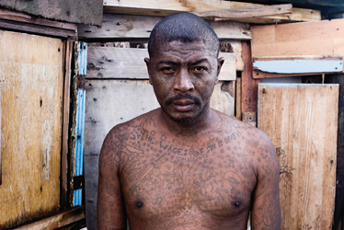
DJ CULTURE

For me, I first really understood the power of the DJ when I was in a small club (Snoopy’s) in S’arenal, Majorca, in 1986. For some reason I was stood near the DJ booth and I watched him cue up a record. He began to play ‘Last Night A DJ Saved My Life’, not at the beginning but at the end of a 12” mix, and as this was pumping out he quickly cued up a different version of the same record then dropped that in, and with that one swift move he had created a live remix. What the fuck did he just do? I was hooked.
If you went back to 1970 in New York, the year dot for DJing, you’d find it all began with a man called David Mancuso. He started holding private parties at his loft apartment in New York that year at 647 Broadway. The first party was called Love Saves The Day. These invitation-only parties became so popular that by 1971 he decided to do this on a weekly basis at 74 and then 99 Prince Street from 1975-1984. The Loft was inspired by Harlem rent parties of the ′20s and ′30s and if you were a member and had no money, David ran an IOU system so you could pay the following week. It was all about being able to be with your friends, dancing and having a good time. It was a true social experiment where all walks of life got down next to each other. This is why it was important. And then there was the sound system. David designed his own unique sound system which was his secret weapon. It wasn’t about volume, it was about quality.
The Paradise Garage opened in NYC in 1976 at 84 Kings Street, the home of legendary DJ Larry Levan. Originally a parking garage, hence the name, it was largely inspired by the loft parties: no food, alcohol or beverages were on sale, and it was not open to the general public.
You had to be a member to get in. As word spread, people would queue round the block each Friday night, hoping to be able to get in with a member, almost prostituting themselves in order to gain entry. Now that’s a club. This was the birthplace of ‘Garage Music’.
‘The club was down some dingy backstreet by the docks. From the outside it was not what I was expecting. Nothing could have prepared me for what I was about to witness inside the club. The place was rammed. The clientele were almost all black, all male and very gay. The club was made up of numerous rooms; it was impossible to get any idea of how big the place actually was as it was so chock-full and difficult to get around. This was like no nightclub that I had ever been in before. The unseen sound system was pumping out tune after tune of which I’d never heard the like before. Mainly they were stripped-back extended mixes of shuddering electro tracks with soul divas’ voices on top; they almost made the Giorgio Moroder records I knew sound like kids’ stuff. Track after track, all seamlessly segueing into each other. Never a drop in the energy level. This was something else altogether. It was literally an ocean away from cheesy Euro disco or the soul-boy sounds that dance clubs would have been playing in the UK… On leaving the place I noticed that it was called “The Paradise Garage”.’
Bill Drummond ex-KLF
Over the sea in Europe, in 1976, a club called Amnesia opened on the Balearic island of Ibiza. DJ Alfredo Fiorito took over as resident DJ Amnesia in 1984 and changed the face of DJing. Turn to p122 to continue the story.
DESiGNERS AGAiNST AiDS
www.designersagainstaids.com
Designers Against Aids came to life in 2004 after long-time fashion journalist, Ninette Murk, and a photographer and music journalist, Javier Barcala, joined forces. Their idea was to build different campaigns that would utilize their serious network of friends (artists, fashion designers, musicians, celebrities) to create different messages of HIV/AIDS awareness using their talent and I vehicles of expression. Starting from fashion collections, they’ve also organized conferences, been involved in music festivals, created video-clips, photographs and moreover, two worldwide campaigns with giant retailer H&M that reached more than 30 countries. DAA have worked with Estelle, Katy Perry, Yoko Ono, Cyndi Lauper, N.E.R.D., Moby, Tokio Hotel, Robyn and Dangerous Muse.
DAA is now training students to start campaigns in regions with dramatic rates of infections (such as China, India, Russia, Ukraine, East Asia and South Africa) through courses at their International HIV/AIDS Awareness Education Center in Antwerp. They’re also looking into possible collaborations with sports celebrities, because they have the power to connect with the youth as much as musicians do and are very great role models.
‘Our goal was always to create messages that would keep the youth interested in AIDS awareness and wouldn’t make them look somewhere else or lose interest.’
Javier Barcala

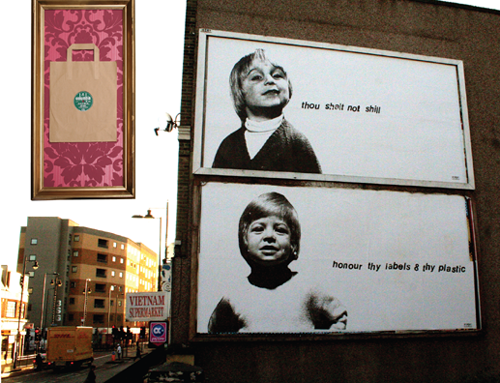
DR D.
www.drd.nu
dr.d is a street artist who specializes in billboard hijacking, which is one of my favourite mediums. Billboards are there to be fucked with (>Culture Jamming p40) and the good doctor does just that. dr.d’s work is a take on life:
‘It’ll either be funny or political, I think the most effective political stuff will have an element of humour that makes it work better.’
He started off just cutting bits from one billboard to stick on another, which was generally just funny or stupid, but…
‘After a while you find that it’s really limiting as to what you’ll end up with, as all you can work with is what the advertisers throw you. Now as well as being technically different (ie I’ll use stencils over posters and even do small scale collage that I then print up billboard size), I suppose my work now has more of a point politically or socially.’
DOT DA GENiUS
I was introduced to Dot’s work when I was cruising the streets of LA (>p156) and ‘Day & Night’ (the tune he wrote & produced fwith Kid Cudi) was on heavy rotation on every urban radio station. I tracked him down and we hooked up at his brand new studio in Brooklyn.
‘I’ve been doing music pretty much my whole life. I went to music school from seven to like fifteen and from then till now I’ve been playing the piano. When I first got to college my roommate did electro/techno music and he gave me my first beat program to make beats on, called Fruityloops - a cracked version. That’s when I first started making beats. I just kept making beats and working with anyone who wanted to work with me, as I was just starting. My A&R first worked with Cudi when he first came to New York and he linked us and we made music for two years straight and then the song just took off.
‘I’ve been influenced by artists from Lily All en to Rick Ross. I was influenced in the beginning by the Neptunes, Timbaland, Swizz Beatz-the staples: the blueprint aseveïpfcne wants to attain that kind of success. All these producers influenced me to do my own thing. You have to jump from one genre to another. A lot of people make the mistake of staying in one lane.’
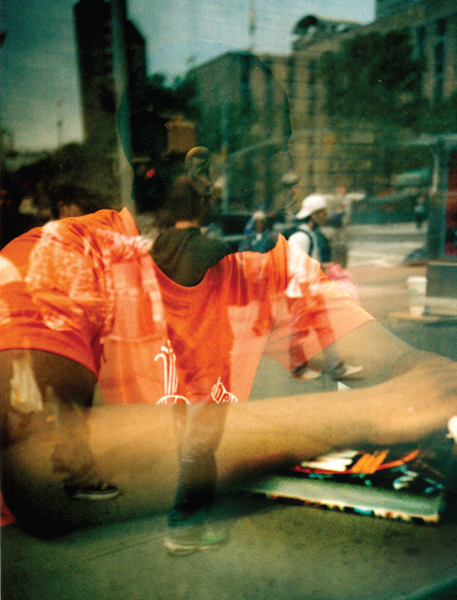
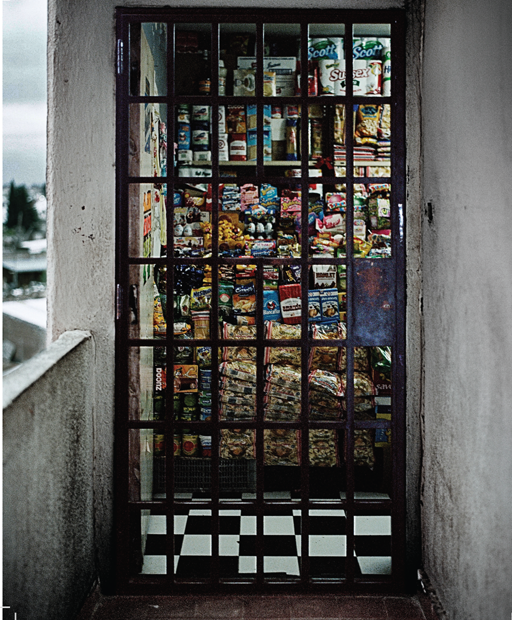

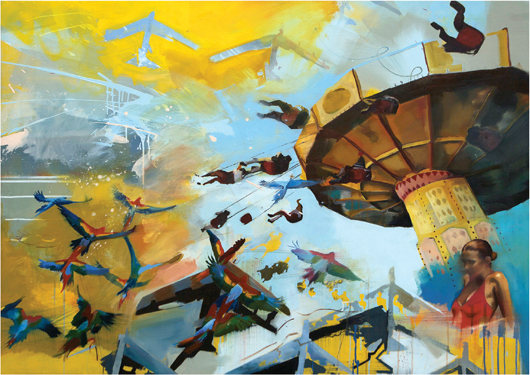
CHOLE EARLY
www.chloeearly.com
Chloe’s work will stop you in your tracks and make you look closer. This is what it’s all about. Her work is simply amazing and unites street influences with fine art sensibilities to create something unique. She grew up in Cork, Ireland, just outside the city.
‘It was beautiful in a mossy, green moist kind of way. We had a lot of space, we climbed trees, nature was close. The city was big enough to have great gigs, bars, clubs, and discovering all that as a teenager seemed like an Aladdin’s Cave of new delights. I think with painting there is always two strands to the work. Painting is an all-encompassing absorbing task, the process becomes the reward.
‘I think a lot about colour, mark making, movement, composition, form; these are the bricks out of which a painting is built. For the viewer the first thing they often relate to is the imagery. Previously, landscape was my primary subject but my emphasis has now switched to the figure. Oil painting and the figure seem to belong to each other and I take a lot of pleasure in painting flesh. But mostly my paintings are about the combinations of imagery I use, unexpected pairings and trying to create a narrative and then drown it out again in paint. It’s a tug of war.
‘When I go to Italy I love seeing extended families walking together in the evenings, talking to the neighbours. I’m sure it’s got a lot to do with the weather but also sadly I think here in the UK the streets are becoming homogenized as the same chains dominate high streets up and down the country, and even from borough to borough in London, it’s all starting to look the same. Perhaps, though, the same things I despair of are one of the reasons why street art and skateboarding have taken off so much in the west, as some kind of territorial way of reclaiming ownership and leaving a mark or belonging to our surroundings.
‘When I think of street culture I think of other countries. Where I live in London there is large African and Turkish communities, the Turks stand outside their barbers, bakeries and flower shops talking late into the night.’
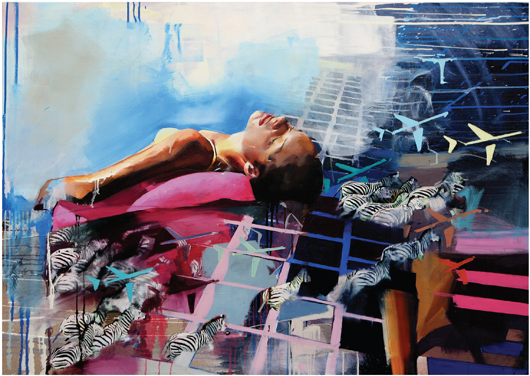
EELUS
http://eelus.com
Eelus is a killer artist who was born in Wigan and has always been fascinated by the darker, weirder side of life. He creates his art on and off the streets, using stencils, spray paint and by hand.
‘Ever since I can remember these are the themes that I’ve worked with just because that’s what’s always in my head. Even when I was very young I remember we’d have to draw some kind of dinosaur scene at school, but my dinosaurs would be being ridden around by other-worldly monsters, hunting and eating people. There would be utter carnage on the paper, the kind of shit you see being drawn by disturbed kids in horror films. Then when I was about ten I found a pirate video in the house that my mum had borrowed from someone at work, The Exorcist and The Texas Chainsaw Massacre, back to back. So there I was, sat crosslegged on the floor in the dark at around 2 am with headphones on and watched both films one after the other. And so began my love of the dark.’
He moved to London where his amazing work caught the eye of everyone who likes art. He does his own thing and this sets him apart.
‘Like I said earlier, I haven’t grown up being part of a graffiti crew and I’ve only ever stepped on a skateboard once in my life, the fucking thing nearly killed me. I know a lot of artists/writers have a chip on their shoulder about other artists who haven’t grown up “on the street”, but fuck that. I’m not trying to prove anything to anybody but myself and I’m certainly not apologetic for never running around a train yard at 4 am with a skateboard under one arm. To me, street culture is about people and the environment they call home. It’s everything from the yoot on the back of the bus with their shit music pumping from their mobile phones to the Turkish ladies making bread in their shop windows down the Kingsland Road.
‘There is no right and wrong with street culture, there’s just people of all walks of life living every day the only way they know how, in the clothes they choose to wear, listening to the music they like, doing the things they like to do. I’ve recently moved to Hastings and the street culture there is similar to that of east London, where I’ve just moved from. There’s quite a young and alternative crowd wearing interesting gear and sweet tattoos, I love it. On the other hand there’s weathered old fishermen with little dogs everywhere drinking by themselves in the quiet local pubs; both are equally as fascinating to me and that to me is street culture.’
His work has steadily evolved into something special.
‘When I first started I used to make small stencils of weird scratchy characters that filled my sketchbooks. From there I practised more and more and got my head around the stencilling process then along came my Shat-at piece which is what really drop-kicked me into the scene properly. From there I did a series of Star Wars themed pieces, a trilogy to go with the original films. These went down well and I was lucky enough to work with Pictures On Walls in making the images into screen prints and get them out to people who wanted them.’


RON ENGLiSH
www.popaganda.com
Ron is America’s most prolific street/pop artist working today, expressing himself through his amazing work both on and off the streets. In 1981 he blew up through his billboard take-overs, subvertising in Dallas, Texas, which, quite rightly, took pot-shots at global brands and their heavy use of advertising. He chose billboards because ‘everyone sees them’. He is one of the founding members of the Culture Jamming movement (>p40) and he questions the ethics of companies such as Apple, McDonald’s, Camel tobacco and Disney through clever re-interpretation of adverts. Back inna day he hand painted the subverts and then pasted them up on billboards; today he uses a large-format printer. But the message is still as sharp and the art as spot-on as it ever was.
Конец ознакомительного фрагмента.
Текст предоставлен ООО «ЛитРес».
Прочитайте эту книгу целиком, купив полную легальную версию на ЛитРес.
Безопасно оплатить книгу можно банковской картой Visa, MasterCard, Maestro, со счета мобильного телефона, с платежного терминала, в салоне МТС или Связной, через PayPal, WebMoney, Яндекс.Деньги, QIWI Кошелек, бонусными картами или другим удобным Вам способом.


